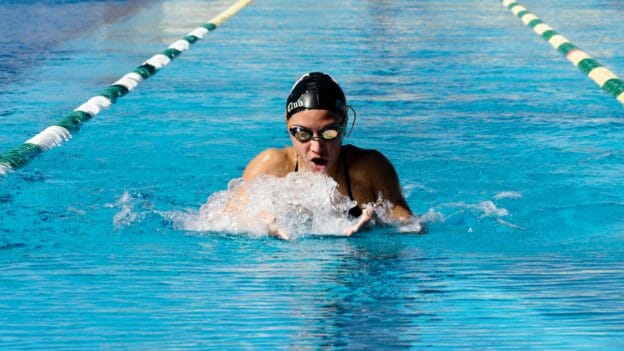Swimming Streamline
At The Race Club we have always preached to our campers to try to swim smarter. Not that there is any way to swim fast easily, but one can also improve time tremendously by focusing on the minute details of technique, by thinking about the right way to swim, rather than simply doing what might feel correct. When it comes to breaststroke and butterfly, in addition to using your brain for developing the fastest way to kick and pull, one can also benefit from the head in another way.
The adult human head weighs about 12 pounds and over all has negative buoyancy (the brain has neutral buoyancy but the skull has negative buoyancy). However, since we lift our head completely out of the water on the front-breathing fly and the breaststroke, the weight goes from 12 pounds on the breath to perhaps a pound when it is immersed in the water. How one chooses to use this weight can make a difference in our swimming speed.
Chin To Chest
Most of the breaststrokers and flyers tend to lay their heads down softly after the breath like they are trying to protect them…a natural instinct. Not only that, they do not allow the head to go down far enough, which is when the chin is at or very near the chest. As a consequence, the head stays in a position of greater frontal drag for a longer time during the stroke cycle.
On the racing dive, when the fingers first touch the water and the body’s speed is around 14 mph, nearly 3 times faster than the men’s 50 meter freestyle world record speed, nearly all swimmers have their chins tucked down to their chests. Frontal drag increases exponentially with speed so getting the head into that position with the streamline seems to reduce the drag as much as possible at that crucial moment. When the head comes down after the breath for the breaststroke or the butterfly, the physics don’t change, even though the body speed is less than with the dive. Getting the chin close to the chest is still the best position to reduce frontal drag.
Headbangers
Some of the fastest breaststrokers and butterflyers don’t just lay their heads down into the water softly after the breath, they snap them down quickly and aggressively into the streamlined position (Peaty, King, Cordes). By doing so, they get the head into this desirable position sooner and keep it there longer than by going the slow, gentle route. Further, the higher kinetic energy of the head moving down, when timed with the propulsion from the kick, will add to this force, resulting in more power from the kick. These combined movements result in the body moving further down the pool along the axis of motion with each stroke.
After the breath in fly or breast, don’t just lay your head down gently, snap it down to a better streamlined position and use this important coupling motion to help get you to the wall first.
Yours in Swimming,
Gary Sr.

